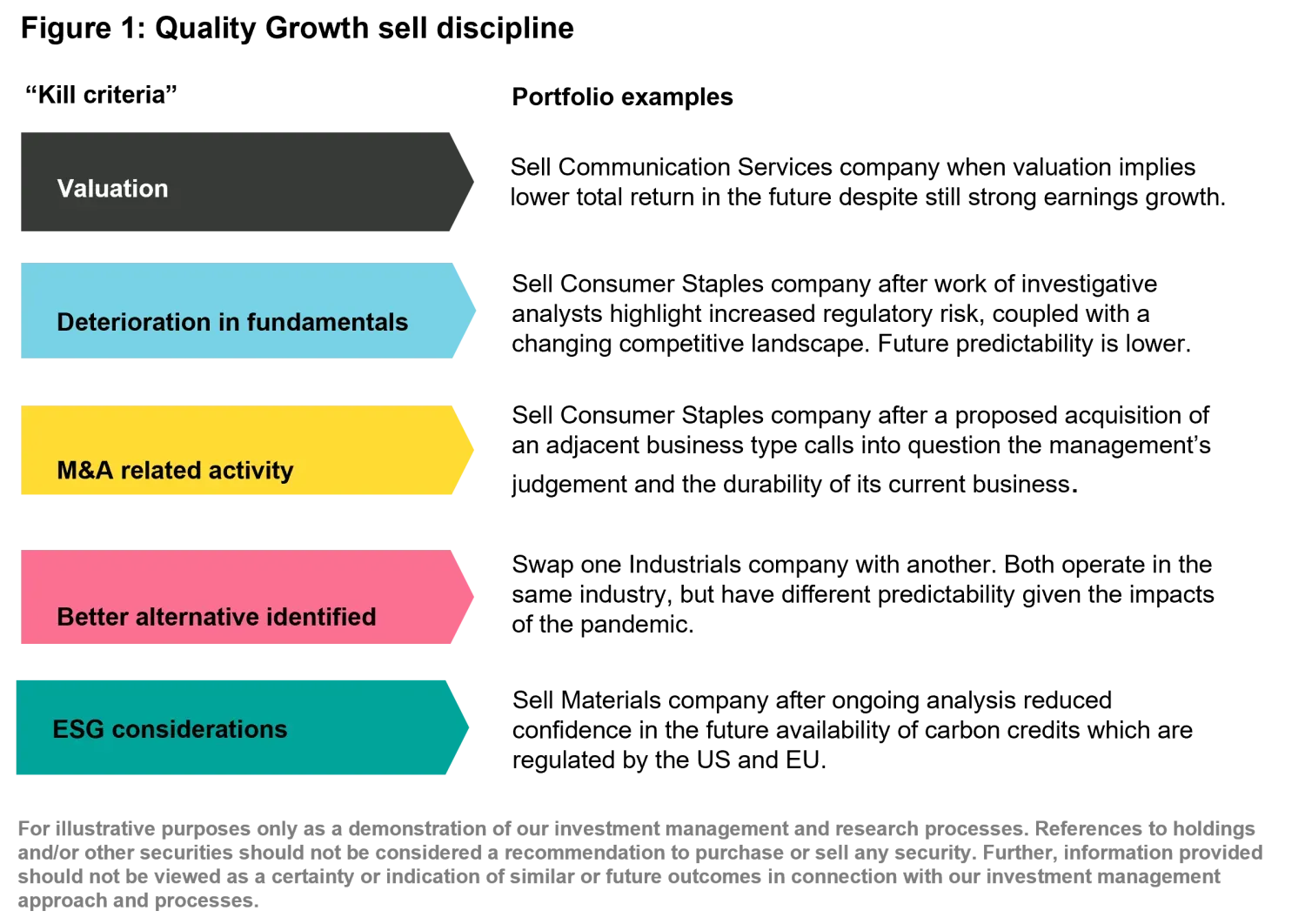“Quitters never win” or do they?
Quality Growth Boutique
When confronted with challenging situations, society often champions perseverance as a sign of strength and the key to success. However, quitting can be just as powerful and sometimes even more lucrative.
In her book “Quit: The Power of Knowing when to Walk Away,” bestselling author Annie Duke makes the case that quitting is a virtue. After all, it is more difficult to break the inertia of following what seems like the path of least resistance, whether it’s your job, an activity, or even a stock.
“Quitting is the tool that allows you to make that different decision when you learn that new information. It gives you the ability to react to the way the world has changed…”
Buying gets all the mindshare
In portfolio management, decision making is paramount and far too often people are only focused on one half of the equation: buying. Every analyst has an impressive thesis on why their idea is the next long-term winner, which makes buying stocks seem like the easy part. But empirical evidence shows that just over 50% of ideas outperform the market. Thus, selling is often the more overlooked and undervalued side of the equation.
Selling is not easy
Selling is uncomfortable, it feels uncertain, and the decision tends to be under more difficult circumstances. Whether it’s endowment bias (overvaluing what you already own), sunk cost fallacy (reluctance to exit due to the effort you’ve already invested) or just plain old Fear of Missing Out, (“FOMO”) there are many reasons why investors fail to quit an investment. In fact, organizational behavior professor Barry Staw’s research in 1976 showed that humans, in the face of negative signals (think thesis changing news), tend to escalate their commitment rather than quit1. We let our thesis creep, rationalize disconfirming evidence, or do more work to gain more confidence, which ultimately keeps us on the path of least resistance, holding onto a losing stock.
Part of what makes selling difficult is knowing how to differentiate between when the investment thesis has changed, which requires an outright sell, versus a short-term issue with the company, which creates a buying opportunity.
But not selling presents the risk of permanent loss of capital
If a stock falls by 50%, the same stock will have to double to break even. Unfortunately, when deciding to sell, investors never have complete information. Only in hindsight we will be able to judge if the decision was correct or not, but alas by then it will be too late.
To answer the sell question, we apply two simple heuristics
First, we ask ourselves “if we did not own it today, would we start a position now?” An important part of this first question is analyzing our “kill criteria” – a clearly defined set of potential breaches that would cause us to sell. Second, we analyze opportunity cost: is there another stock in the portfolio or in our recommended buy list that we like more?
Fortunately, if our sell decision proves to be wrong, we can always buy the stock again later. What we can’t do, however, is recover our permanent loss of capital due to our hesitation to sell the stock. Our main concern is not FOMO, rather it is Fear of Losing Money (FOLM).
For example, in our International Equity strategy we owned Alimentation-Couche Tard, a retail company based in Canada. This was once a predictable business operating gas station convenience stores that had a compound annual growth rate (cagr) of 21% for 10 years ending 2023. Couche-Tard checked all of our boxes, it was predictable, defensive, growthy, and low risk. The company eventually reached the limits of its bolt-on strategy and began to pursue larger M&A of retail/grocery and convenience stores that required much heavier lifting to turn around these assets, which was outside of the company’s core competency. Out of concern that the predictability of the business was declining, we asked our Investigative Analyst Robert Berner to complete intensive boots-on-the-ground research. His findings were overwhelmingly negative. We sold the position and since that time the business, as well as the stock, has underperformed.
RB Global, on the other hand, is a stock that we decided to add on weakness. RB Global’s principal business was once just an auctioneer of “yellow iron” construction equipment. A dominant two-sided network connecting buyers and sellers that was a perennial market share gainer. The company purchased IAA (International Auto Auctions), the second and weaker player of the duopolistic salvage automobile auction market. Analysts questioned the validity of the acquisition and whether IAA could be turned around. We again sent our Investigative Analyst out to spend time in the field probing customers, salvage yards and competitors. This time the feedback was overwhelmingly positive, and we added the stock to our portfolios.
In summary, we believe that when predictability is impaired, the kill criteria is crossed, or the thesis has changed, it’s time to walk away – or even run – to a more predictable business.

1. Source: ScienceDirect, Organizational Behavior and Human Performance, June 1976, Barry Staw, “Knee-deep in the big muddy: a study of escalating commitment to a chosen course of action”
References to strategy/portfolio holdings and other companies are for illustrative purposes only as of the date of publication to elaborate on the subject matter under discussion. Information provided should not be considered research or a recommendation to purchase, hold, or sell any security nor should any assumption be made as to the present or future profitability or performance of any company identified or security associated with them. There is no assurance that any securities discussed herein will remain in the strategy at the time you receive this communication, or that securities sold have not been repurchased. Securities discussed may represent only a certain percentage of a portfolio’s holdings. Refer to the “Related Strategies/Funds” for further evaluation.
Any projections or forward-looking statements regarding future events or the financial performance of countries, markets and/or investments are based on a variety of estimates and assumptions. Such information should not be regarded as an indication that Vontobel considers these forecasts to be reliable predictors of future events and they should not be relied upon as such. Actual events or results may differ materially and, as such, undue reliance should not be placed on such forward-looking information.








